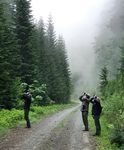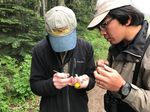Trees and bushes, home sweet home for warblers - Data ...
←
→
Page content transcription
If your browser does not render page correctly, please read the page content below
Name_________________
Trees and bushes, home sweet home for warblers
Featured scientists: Hankyu Kim, Matt Betts, and Sarah Frey from Oregon State
University. Written with Eric Beck from Realms Middle School and Kari O’Connell from
Oregon State University.
Research Background:
The birds at a beach are very different
from those in the forest. This is because
each bird species has their own set of
needs that allows them to thrive where
they live. Habitats must have the right
collection of food to eat, places to shelter
and raise young, safety from predators,
and the right environmental conditions like
temperature and moisture.
The vast coniferous forests of the Pacific
Northwest provide rich and diverse habitat
types for birds. These forests are also a
large source of timber, meaning they are
economically valuable for people.
Disturbances from logging and natural
events result in a forest that has many
different habitat types for birds to choose
from. In general, areas of forest that have Matt, Sarah, and Hankyu – a team of scientists
been harvested more recently will have at Andrews Forest, measuring bird populations.
more understory, such as shrubs and short
trees. Old-growth forests usually have higher plant diversity and larger trees. They are
also more likely to have downed trees or standing dead trees, which are important for
some bird species. Other disturbances like wildfire, wind, large snow events, and forest
disease also have large impacts on bird habitat.
At the Andrews Forest Long-Term Ecological Research site in the Cascade Mountains
of Oregon, scientists have spent decades studying how the plants, animals, land use,
and climate are all connected. In the past, Andrews Forest had experiments
manipulating timber harvesting and forest re-growth. This land use history has large
impacts on the habitats found in an area. Many teams of scientists work in this forest,
each with their own area of research. Piece by piece, like assembling a puzzle, they
combine their data to try to understand the whole ecosystem.
Data Nuggets co-developed by Michigan State University scientists and teachers in the GK-12 Partnership.
1Name_________________
Matt, Sarah, and Hankyu have been
collecting long-term data on the
number, type, and location of birds
in Andrews Forest since 2009. Early
each morning, starting in May and
continuing until late June, teams of
trained scientists hike along
transects that go through different
forest types. Transects are parallel
lines along which data are collected.
At specific points along the
transect, the team would stop and
listen for bird songs and calls for 10
minutes. There are 184 survey
locations, and they are visited Collecting data on a warbler.
multiple times each year.
At each sampling point, Matt, Sarah, and Hankyu carefully recorded a count for each
bird species that they hear within 100 meters. They then averaged these data for each
location along the transect to get an average number for the year. The scientists were
also interested in the habitats along the transect, which includes the amount of
understory plants and tall trees, two forest characteristics that are very important to
birds. They measured the percent cover of understory vegetation, which shows how
many bushes and small plants were around. They also measured the size of trees in
the area, called basal area.
Using these data, the research team is looking for patterns that will help them identify
which habitat conditions are best for different bird species. With a better understanding
of where bird species are successful, they can predict how changes in the forest could
affect the number and types of birds living in Andrews Forest and nearby.
Wilson’s Warblers and Hermit Warblers are two of the many songbirds that these
scientists have recorded at Andrews Forests. Wilson’s Warblers are small songbirds
that make their nests in the understory of the forests. Therefore, the team predicted
that they would see more of Wilson’s Warblers in forest areas with more understory
than in forest areas with less understory. Hermit Warblers, on the other hand, build
nests in dense foliage of tall coniferous trees and search for spiders and insects in
those coniferous trees. The team predicted that the Hermit Warblers would be
observed more often in forest plots where there are larger trees.
Scientific Question: What are the habitat conditions where the most Wilson’s Warblers
and Hermit Warblers are found?
Data Nuggets co-developed by Michigan State University scientists and teachers in the GK-12 Partnership.
2Name_________________
Scientific Data: The tables below show the data from 20 study locations in Andrews
Forest, averaged across 11 years of long-term data collection.
Use the data below to answer the scientific question:
Location Number of Hermit Coniferous Location Number of Wilson's Coniferous
along Warblers detected Understory tree basal along Warblers detected Understory tree basal
transect (1-year average) Cover (%) area transect (1-year average) Cover (%) area
PA329 10.0 36 4.4 PB052 11.8 88 2.6
PA309 14.6 16 3.8 PB264 1.8 64 2.4
PA322 11.8 25 4.0 PA241 0.9 86 2.4
PA304 13.6 5 5.8 PB269 0.9 60 2.4
PA246 10.0 16 2.8 PA062 3.6 51 1.6
PC017 20.0 0 4.2 PA317 0.0 54 2.2
PB225 24.6 34 4.8 PA041 10.9 100 0.0
PA018 8.2 26 3.8 PA076 1.8 91 3.0
PB264 26.4 64 2.4 PB022 2.7 58 4.0
PA256 1.8 27 2.4 PB268 2.7 54 2.6
PA207 4.6 30 3.0 PA019 0.9 4 5.6
PC007 19.1 4 6.4 PA328 0.0 2 5.8
PA009 9.1 11 6.0 PA020 0.9 3 4.4
PB201 11.8 6 3.8 PA204 0.0 1 2.6
PB244 10.9 17 3.8 PB278 0.0 3 6.0
PB335 13.6 44 0.4 PA259 1.8 6 1.6
PB014 11.8 70 4.4 PB067 0.9 6 6.0
PA249 17.3 16 4.0 PA032 7.3 10 6.0
PA210 5.5 25 4.0 PA077 0.9 4 4.4
PA341 7.3 17 3.8 PA304 0.0 5 5.8
PA080 10.0 5 4.2 PA306 0.0 9 6.8
PA064 17.3 41 3.8 PB302 0.0 13 4.2
PB337 11.8 20 2.0 PA351 1.8 16 3.8
PA044 7.3 6 4.6 PC017 2.7 0 4.2
PA340 8.2 23 1.2 PA017 0.9 7 3.4
PA032 18.2 10 6.0 PA334 0.0 9 2.8
PB316 34.6 22 3.6 PA349 0.0 14 3.4
PA328 20.9 2 5.8 PA258 2.7 20 2.6
PB278 26.4 3 6.0 PA324 0.9 0 5.6
PA265 24.6 20 2.2 PC018 1.8 23 4.0
* Understory cover (%) is a measure of the amount of area covered by understory deciduous
shrubs. Coniferous tree basal area is a measure of the amount of coniferous trees and is
strongly related to the size of the trees in a given area. The basal area is measured as square
feet per acre, and expressed as 100 square feet per acre
Which data will you graph to answer the question?
Independent variable(s):
Dependent variable(s):
Data Nuggets co-developed by Michigan State University scientists and teachers in the GK-12 Partnership.
3Name_________________
Draw your graphs below: Identify any changes, trends, or differences you see in your
graphs. Draw arrows pointing out what you see and write one sentence describing
what you see next to each arrow.
38
36
34
32
Number of Warblers (1-year average)
30
28
26
24
22
20
18
16
14
12
10
8
6
4
2
0
0 10 20 30 40 50 60 70 80 90 100 110
Understory cover (%)
38
36
34
32
Number of Warblers (1-year average)
30
28
26
24
22
20
18
16
14
12
10
8
6
4
2
0
0 1 2 3 4 5 6 7 8
Coniferous tree basal area
Data Nuggets co-developed by Michigan State University scientists and teachers in the GK-12 Partnership.
4Name_________________
Interpret the data:
Make a claim that answers the scientific question: What are the habitat conditions
where the most Wilson’s Warblers and Hermit Warblers are found?
What evidence was used to write your claim? Reference specific parts of the tables or
graphs.
Explain your reasoning and why the evidence supports your claim. Connect the data
back to what you learned about the two warbler species and their preferred habitats.
Data Nuggets co-developed by Michigan State University scientists and teachers in the GK-12 Partnership.
5Name_________________
Your next steps as a scientist:
Science is an ongoing process. What new question do you think should be
investigated?
What future data should be collected to answer your question?
Independent variable(s):
Dependent variable(s):
For each variable, explain why you included it and how it could be measured.
What hypothesis are you testing in your experiment? A hypothesis is a proposed
explanation for an observation, which can then be tested with experimentation or other
types of studies.
Data Nuggets co-developed by Michigan State University scientists and teachers in the GK-12 Partnership.
6You can also read



















































